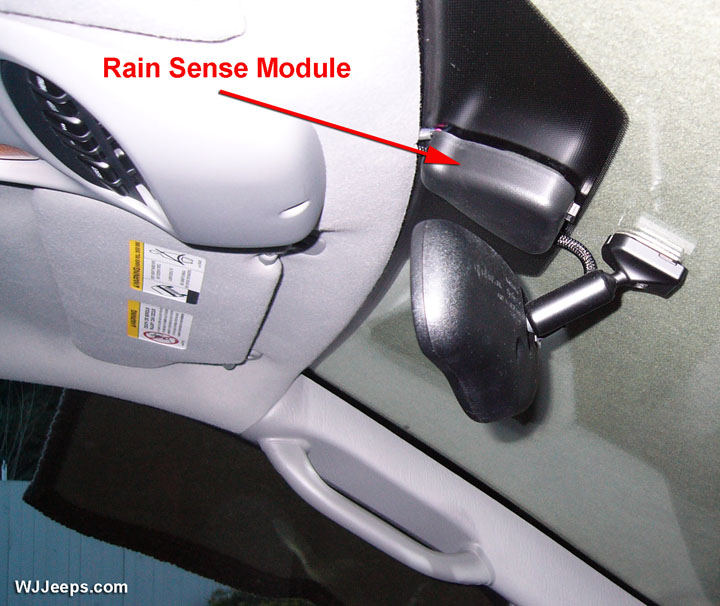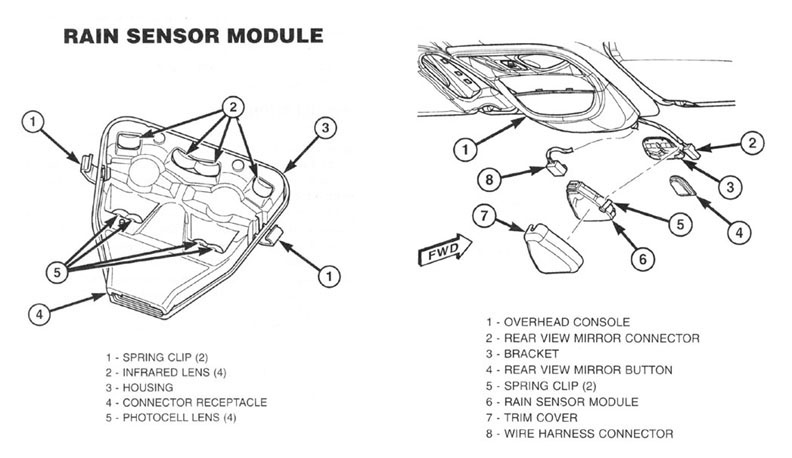Welcome to the JeepSpecs.com in-depth page on WJ Generation Jeep Grand Cherokee rain sense wipers. We have organized as much information as we could find into a helpful article below. Is something incorrect or missing? Please get in touch with us and we’ll fix it!

The Rain Sense wipers feature was first introduced for the 2002 model year. They were optional on the Limited, standard on the Overland but not available on the Laredo, Laredo Sport or Special Edition models. The Rain Sensor module is located on the inside of the windshield, between the rear view mirror mounting button and the windshield header and is concealed behind a molded plastic trim cover that snaps over the module housing.
Unlike prior windshield wiper systems, the intermittent mode is no longer based off a preprogrammed time delay. The sensor adjusts the time delay based off how much moisture it detects on the windshield, the different intermittent modes just determines the sensitivity. You could have the intermittent switch in any position and if there is never a drop of water on the windshield, the wipers will never swipe.

RSM MODULE
The Rain Sensor Module (RSM) is the primary component of the automatic wiper system. The triangular-shaped molded black plastic housing of the RSM has a rectangular opening located on the upper end of the housing for the module connector receptacle, which contains four terminal pins. These terminal pins connect the rain sensor to the vehicle electrical system through a dedicated take out and connector of the overhead wire harness that extends from above the headliner. Five openings on the windshield side of the RSM housing are fitted with eight convex clear plastic lenses. A metal spring clip on each side of the housing near the bottom secures the RSM to a plastic mounting bracket that is bonded to the windshield glass. Concealed within the RSM housing is the electronic circuitry of the module, which includes four InfraRed (IR) diodes, two photocells, and a microprocessor.
The RSM software is Flash compatible, which means it can be reprogrammed using Flash reprogramming procedures. However, if any of the hardware of the RSM is damaged or faulty, the entire module must be replaced.
MODULE REPLACEMENT / REATTACHEMENT
According to Jeep, the RSM bracket is serviced as a unit with the windshield glass. If the bracket is faulty, damaged, or separated from the windshield glass, the windshield must be replaced.
Update February 2011: There is a kit that includes the lens/bracket and adhesive that allows a detached or damaged RSM bracket to be reattached without replacing the windshield. The kit is sold by TechnologyLK and is called “CRL Rain and Light Sensor Lenses”. The same company also offers a Rain and Light Sensor Refurbishing Kit. Both are available from Amazon.com.
OPERATION
The control knob on the end of the right (wiper) multi-function switch control stalk is rotated to one of five minor intermediate detents to select the desired automatic wipe sensitivity level. The control knob is rotated rearward (counterclockwise) to reduce the sensitivity (increase the interval between wipes), or forward (clockwise) to increase the sensitivity (decrease the interval between wipes). The right (wiper) multifunction switch provides a resistor multiplexed output to the Body Control Module (BCM) on a windshield wiper switch mux circuit. The BCM responds by sending an electronic message to the Rain Sensor Module (RSM) over the Programmable Communications Interface (PCI) data bus indicating the selected sensitivity level, and by operating the front wiper system based upon electronic wipe commands received from the RSM over the PCI data bus.
The microprocessor-based Rain Sensor Module (RSM) senses moisture in the wipe pattern on the outside of the windshield glass and sends wipe commands to the Body Control Module (BCM). Four InfraRed (IR) diodes within the RSM generate IR light beams that are aimed by four of the convex optical lenses near the base of the module through the windshield glass. Four additional convex optical lenses near the top of the RSM are focused on the IR light beams on the outside of the windshield glass and allow the two photocells within the module to sense changes in the intensity of these IR light beams. When sufficient moisture accumulates within the wipe pattern of the windshield glass, the RSM detects a change in the monitored IR light beam intensity.
The internal programming of the RSM then sends the appropriate electronic wipe command messages to the BCM over the Programmable Communications Interface (PCI) data bus. The BCM responds by activating or deactivating the front wiper system. The BCM also sends electronic sensitivity level messages to the RSM over the PCI data bus based upon the driver-selected sensitivity setting of the control knob on the control stalk of the right (wiper) multifunction switch. The higher the selected sensitivity setting the more sensitive the RSM is to the accumulated moisture on the windshield glass, and the more frequently the RSM will send wipe commands to the BCM to operate the front wiper system.
The RSM operates on battery current received through a fuse in the Junction Block (JB) on a fused B(+) circuit. This circuit is switched by the power accessory (sunroof) delay relay in the JB so that the RSM will operate whenever the relay is energized by the BCM. The RSM receives ground at all times through a take out of the left body wire harness with an eyelet terminal that is secured by a ground screw to the front seat crossmember on the floor panel under the left front seat. It is important to note that the default condition for the wiper system is automatic wipers Off; therefore, if no message is received from the RSM by the BCM for more than about five seconds, the automatic wipers will be disabled and the BCM will default the front wiper system operation to the low speed continuous wipe mode.
UPGRADING
It is not known if the components of the Rain Sense system can be successfully added to vehicles that did not originally have this option.

